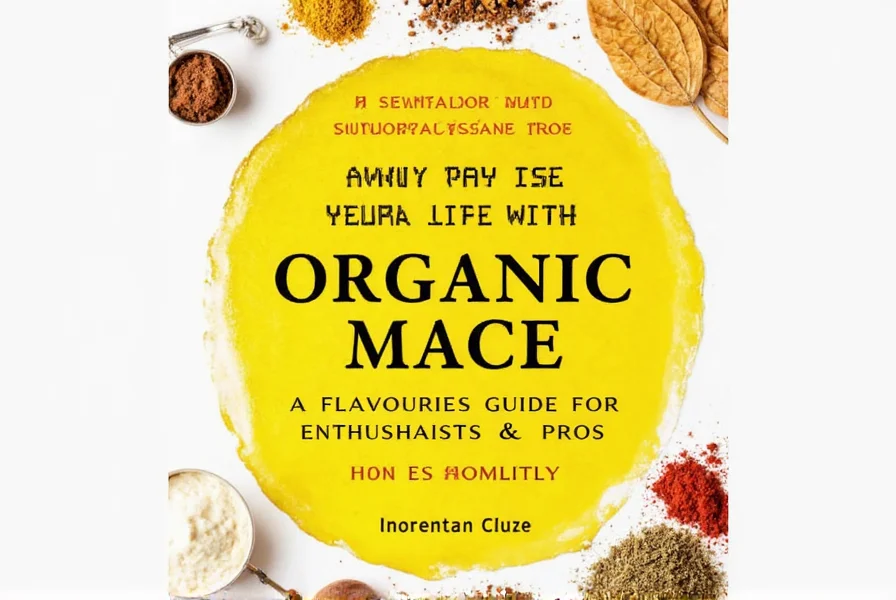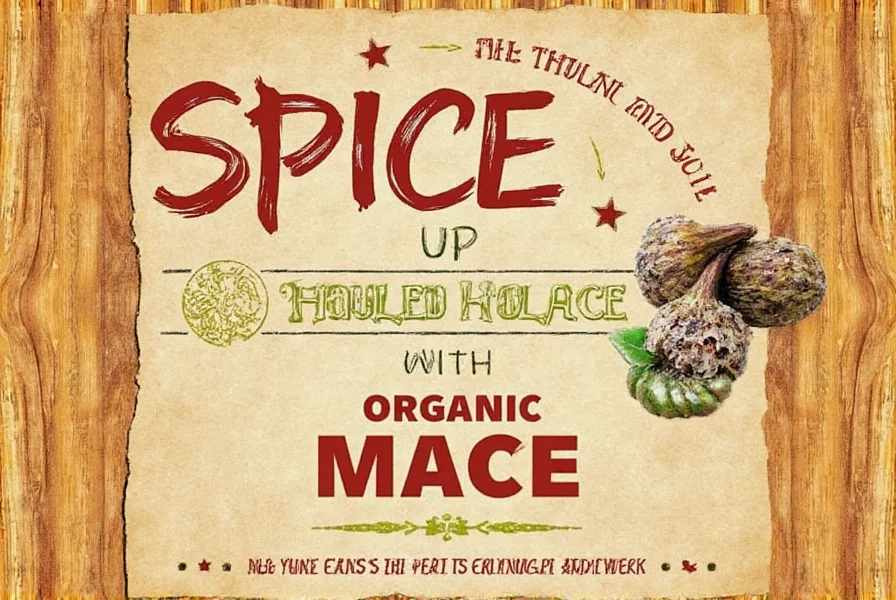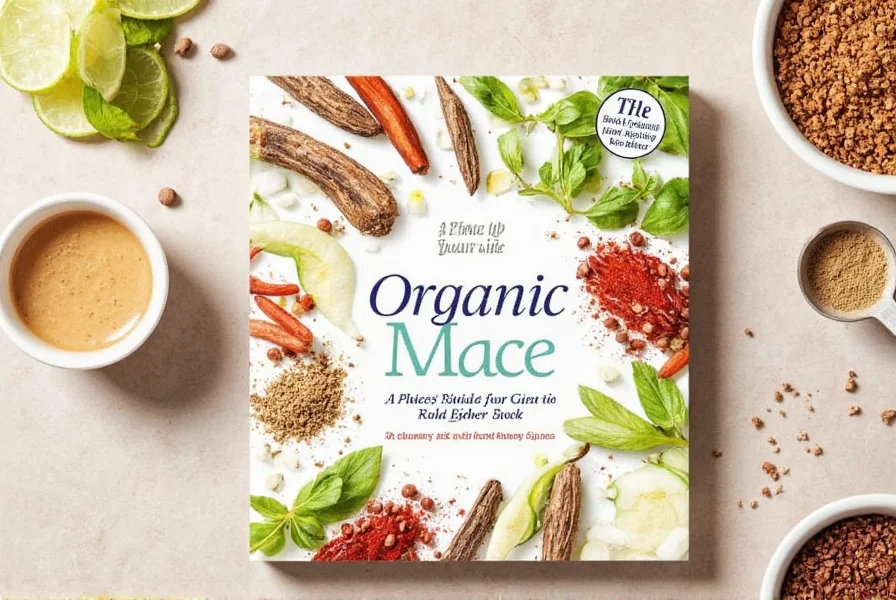Table of Contents
What is Organic Mace?
Organic mace is the dried, lacy red aril (outer covering) of the nutmeg seed from the Myristica fragrans tree, grown without synthetic pesticides or fertilizers. This spice is harvested when the fruit splits open, revealing the bright red mace surrounding the nutmeg seed. After careful drying, it becomes a versatile culinary ingredient prized for its unique flavor profile. Unlike conventional mace, organic varieties ensure no chemical residues while supporting sustainable farming practices.

The Flavor Profile of Organic Mace
Organic mace offers a complex, delicate flavor that combines warm sweetness with citrusy brightness and subtle floral notes. It shares similarities with nutmeg but is lighter, more nuanced, and less overpowering. Think of it as a blend of cinnamon, nutmeg, and a hint of lemon zest with a smooth, aromatic finish. This makes it exceptionally versatile for both sweet and savory applications where a refined spice is needed.
Cooking with Organic Mace
Organic mace elevates dishes with its sophisticated flavor. Here are expert-approved ways to use it:
- Baking: Add 1/4 teaspoon to pumpkin pie filling for brighter notes, or mix into gingerbread dough for complex warmth. Perfect for spice cakes, shortbread cookies, and cinnamon rolls.
- Savory Dishes: Sprinkle over roasted root vegetables (carrots, sweet potatoes) with olive oil and honey. Use in meatloaf, braised short ribs, or creamy mushroom sauces for depth without overpowering.
- Drinks: Infuse mulled wine with a whole mace blade for citrusy complexity, or stir 1/8 teaspoon into hot chocolate for a sophisticated twist. Perfect for spiced chai tea or eggnog.
- Dairy & Breakfast: Top Greek yogurt with honey and a pinch of mace, or add to oatmeal with dried fruit. Enhance cream of mushroom soup or béchamel sauce for extra richness.
Pro Tip: For maximum flavor, grind whole mace blades fresh using a spice grinder just before use. Pre-ground mace loses potency quickly.
Buying Guide for Organic Mace
Selecting quality organic mace requires attention to these key factors:
Key Features to Look For
- Certification: Verify USDA Organic or EU Organic certification on packaging. Avoid products labeled "natural" without official certification.
- Form: Whole mace blades (reddish-orange, 1-2 inch pieces) retain flavor longer than ground. Grind only what you need for peak freshness.
- Source: Look for mace from Sri Lanka or Indonesia, known for superior quality. Reputable brands include Spice House and Penzeys which trace their sourcing transparently.
- Appearance: Whole mace should be vibrant orange-red with a slight sheen. Avoid dull, brownish pieces which indicate age.
Tips for Storing Organic Mace
Proper storage preserves mace's delicate flavor for up to 2 years:
- Container: Store in an airtight glass jar with a tight-sealing lid. Avoid plastic containers which can absorb odors.
- Location: Keep in a cool, dark pantry away from heat sources like stoves or ovens. Direct sunlight rapidly degrades flavor.
- Labeling: Write the purchase date on the container. Whole mace stays fresh for 18-24 months; ground mace should be used within 6-8 months.
- Quantity: Buy small quantities (1-2 ounces) if you don't use it frequently. Mace loses potency faster than many other spices.

Comparison Table: Organic vs. Non-Organic Mace
| Feature | Organic Mace | Non-Organic Mace |
|---|---|---|
| Chemical Use | No synthetic pesticides or fertilizers | Typically treated with chemical pesticides |
| Flavor Quality | Richer, more complex, and aromatic | Often duller with potential chemical aftertaste |
| Environmental Impact | Supports sustainable farming practices | Potential soil and water contamination |
| Health Safety | Zero chemical residues | Possible pesticide residues detected in testing |
| Price Range | $8-$15 per ounce (higher due to certification) | $4-$8 per ounce (lower production costs) |

Conclusion
Organic mace is a culinary gem that transforms ordinary dishes with its sophisticated flavor profile while supporting ethical agriculture. By choosing certified organic varieties, you avoid chemical residues and contribute to sustainable farming practices. Whether you're baking holiday treats, enhancing savory sauces, or creating comforting beverages, organic mace delivers superior flavor and peace of mind. Start experimenting with this versatile spice to elevate your cooking to professional levels.

Frequently Asked Questions About Organic Mace
What is the difference between mace and nutmeg?
Mace and nutmeg come from the same fruit of the Myristica fragrans tree. Nutmeg is the seed inside the fruit, while mace is the delicate red aril (outer covering) surrounding the seed. Mace has a lighter, more citrusy flavor compared to nutmeg's stronger, warmer profile. They're often used together but can be substituted with adjustments.
How does organic mace differ from regular mace?
Organic mace is grown without synthetic pesticides or fertilizers, resulting in cleaner flavor and no chemical residues. Regular mace often contains pesticide residues that can affect taste and safety. Organic certification also ensures ethical farming practices and environmental sustainability, making it a superior choice for health-conscious cooks.
What does organic mace taste like?
Organic mace has a delicate, complex flavor profile combining warm sweetness, citrusy brightness, and subtle floral notes. It's often described as a blend of cinnamon, nutmeg, and lemon zest with a smooth, aromatic finish. Unlike conventional mace, organic varieties maintain pure flavor without chemical aftertastes.
How should I store organic mace to keep it fresh?
Store whole organic mace in an airtight glass jar away from light and heat. A cool, dark pantry is ideal. Whole blades stay fresh for 18-24 months, while ground mace should be used within 6-8 months for peak flavor. Always label containers with purchase dates to track freshness.
Can I substitute nutmeg for mace in recipes?
Yes, but with adjustments. Use 1/4 teaspoon of nutmeg for every 1/2 teaspoon of mace called for in a recipe, as nutmeg has a stronger flavor. For best results, consider adding a pinch of cinnamon to mimic mace's citrus notes when substituting. Always taste and adjust as needed.
What are the health benefits of organic mace?
Organic mace contains natural antioxidants and anti-inflammatory compounds. Traditional uses include aiding digestion and reducing bloating. Crucially, organic certification ensures no pesticide residues, making it safer for regular consumption. Always consult a healthcare provider for medical advice regarding health benefits.
How long does organic mace last?
Whole organic mace blades maintain optimal flavor for 18-24 months when stored properly in airtight containers away from light and heat. Ground mace loses potency faster and should be used within 6-8 months. Always check for freshness by smelling - if it lacks aroma, it's past its prime.
What are the best ways to use organic mace in cooking?
Organic mace shines in both sweet and savory dishes. Use it in pumpkin pie, gingerbread, and spice cakes for complex warmth. Add to roasted vegetables, meatloaf, and creamy sauces for depth. Stir into mulled wine, hot chocolate, or chai tea for aromatic complexity. For maximum flavor, grind whole blades fresh just before use.










 浙公网安备
33010002000092号
浙公网安备
33010002000092号 浙B2-20120091-4
浙B2-20120091-4